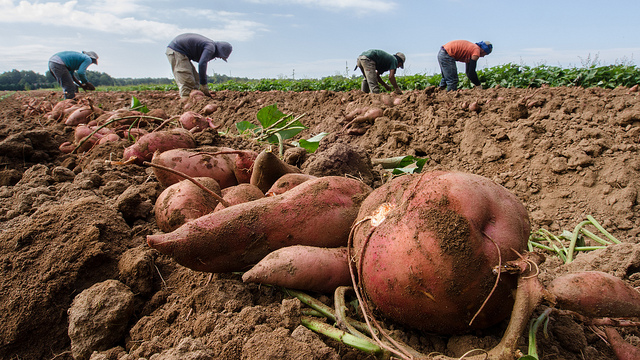 Plant Biology
Plant Biology
GMOs are not a human invention: sweet potato is a naturally transgenic food crop
Genetically modified organisms can be the natural result of environmental interactions between plants and their surroundings.

Sweet potato is one of the most important food crops for human consumption in the world. It is especially grown and consumed in Sub-Saharan Africa, parts of Asia, and the Pacific islands. Additionally, it is one of the earliest domesticated crops, documented by archeological findings in caves of the Chilca Canyon in Peru that are 8,000 to 10,000 years old.
While searching the sweet potato genome – this is the entire DNA-code – for viral diseases, researchers in Peru unexpectedly discovered DNA sequences of the bacterium ‘Agrobacterium’. Instead of contributing this peculiar finding to bacterial contamination of the plant samples (as is usually done in similar studies), they decided to study these sequences in more detail. They teamed up with different laboratories spread all over the world, including ours at Ghent University in Belgium, to provide independent evidence for their observations. Different complementary DNA analyses were executed, undoubtedly demonstrating that two large pieces of bacterial DNA were stably integrated in the sweet potato genome. Moreover, it was shown that the added bacterial genes were active inside the sweet potato plant tissue. The fact that these genes are still active in sweet potato, after probably thousands of years, suggests that they provided a positive characteristic, which was selected for by farmers during the domestication of this plant.
The presence of the two bacterial DNA pieces was further investigated across a large set of different sweet potato varieties grown in the world. The DNA analyses confirmed that one of the two foreign DNA sequences was present in each of the more than 200 tested sweet potato varieties. The second piece of bacterial DNA was present in about one fourth of the tested samples, and even in some related wild species.
This is not the first time that researchers find bacterial, fungal, or viral DNA in the genome of plants or animals. Genome analyses in recent years find more and more examples of possible “horizontal gene transfers”. In an event of horizontal gene transfer, genes are exchanged between different species – in contrast to normal gene transfer from parents to progeny, which occurs within one species. Already in the late 1970s, it was discovered that Agrobacterium is able to transfer a part of its own DNA, the so-called transfer DNA or T-DNA, to a few specific plant cells. Agrobacterium uses this process during its pathogenicity on plants, to induce the formation of crown galls or hairy root disease. It is this T-DNA that we have found inside the genome of sweet potato, although all analyzed plants were completely healthy.
The mechanism used by Agrobacterium to incorporate its own T-DNA in the genetic material of plants forms the basis of the plant GMO (genetically modified organism) technology. While Agrobacterium naturally introduces its T-DNA only in a few plant cells, biotechnologists have succeeded to regenerate complete plants from these modified cells. GMO plants are currently grown on more than 10% of the world’s agricultural lands, but are still debated very controversially. The finding of T-DNAs in sweet potato now reveals that this plant has naturally acquired Agrobacterium genes in the course of its evolution, most likely already thousands of years ago. The natural presence of Agrobacterium T-DNA in sweet potato and its stable inheritance during evolution is a beautiful example of the possibility of DNA exchange across species barriers. It demonstrates that genetic modification also happens in nature.
Given the fact that sweet potato has been cultivated and eaten for thousands of years, this discovery might change the paradigm about the ‘unnatural’ status of GMO food.
Original Article:
Kyndt T, Quispe D, Zhai H, Jarret R, Ghislain M, Liu Q, Gheysen G, Kreuze J. The genome of cultivated sweet potato containsAgrobacteriumT-DNAs with expressed genes: An example of a naturally transgenic food crop. Proceedings of the National Academy of Sciences. 2015;112(18):5844-5849. doi:10.1073/pnas.1419685112.Next read: Lego blocks for precise gene editing by Jared Carlson-Stevermer
Edited by:
Dr. Tobias Preuten , Editorial Advisor - Review operation manager
We thought you might like
A new code for a new life
May 26, 2016 in Maths, Physics & Chemistry | 3.5 min read by Jordan CostafrolazAmoebas trap bacteria using nets of DNA: the same mechanism as human immune cells
Jan 27, 2017 in Evolution & Behaviour | 3.5 min read by Lukáš NovákWhat happens to our genes in the twilight of death?
Feb 28, 2017 in Health & Physiology | 3.5 min read by Peter Noble , Alex PozhitkovHuman gut parasite has a sinister use for its stolen genes
May 18, 2017 in Evolution & Behaviour | 3 min read by Lukáš NovákMore from Plant Biology
Unravelling the Secrets of Pine Roots: A Tale of Nutrition and Adaptation
Oct 20, 2023 in Plant Biology | 3.5 min read by Rafael Cañas , Francisco OrtigosaStressful memories help plants resist caterpillars
Oct 2, 2023 in Plant Biology | 3.5 min read by Samuel Wilkinson , Adam Hannan Parker , Jurriaan TonDecoding the genome of a jackfruit that grows all year round
Sep 6, 2023 in Plant Biology | 3.5 min read by Tofazzal IslamLife after logging: the tale of recovering tropical forests
Aug 21, 2023 in Plant Biology | 3.5 min read by Maria Mills , Terhi RiuttaEditor's picks
Trending now
Popular topics


